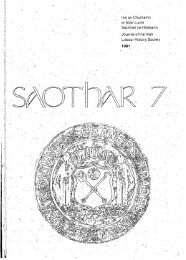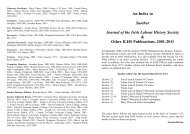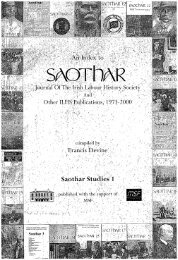40 SAOTHAR13Labour Party complemented these aspirations. Both were the means of introducing necessary reform,to bring to the worker 'economic power and even ... the much talked of social revolution, without anylapse int9 anarchy and bloodshed' .76 In this regard, her commitment was total, and uncompromising.Not surprisingly, she was appalled at the conflict between the Irish and British-based unions, andbetween the JimLarkins, Senior and Junior, and William O'Brien. Soon after the split in the LabourParty, Bennett approached and wrote confidentially to Thomas Johnson pleading with him to act as 'anappeaser' in the 'dreadful impasse' and urging the necessity to 'push the old feud into the background'.77Herimpassioned speech at the ITUC conference in 1945 took up the theme again anddeserves quoting at length:'The present 'split' is really tragic from the point of view of friendship ... What the Irish Unions ask us todo is really betray the principles of freedom of association. They are asking us to agree that pressure maybe put on large groups ofIrish workers to make them leave the Unions of their choice. If we were to makesuch an attack on this principle we would betray our movement and put ourselves in the hands of thegovl!Wment of the twenty-six counties and they would have the right and the power to lead fueTradeUnions in any way they wished. We know they have a very strong wish to control the Trade Unions andfrom i!very point of view we must resist any attempt to put pressure on the rank and file to leave the Unionsof tl1eir choice. We must oppose, yet more, any effort to make a high wall between Northern and SouthernIreland. '7 8 ..When the split within the unions followed, Bennett kept the IWWU within the ITUC, being co-optedonto thelTUC executive in April 1945 in place of five who resigned. In 1946, she was elected VicePresident of Congress, becoming President for the second time (the first was in 1931-32) for 1947-48.She remained on the executive unti11950, and as General Secretary of the IWWU until her retirementin 1955.The IWWU under her leadership was forthright in its promotion of numerous issues that affectednot alone the woman worker, but also her husband and children. Delegates made frequent calls to raisethe schoo1leavihg age; to provide adult and continuing education; to provide school meals for thoseunable to go home; to strictly limit juvenile employment; to improve social services, pensions, andhealth facilities by way of an all-inclusive insurance scheme; to introduce factory inspectors,particularly in the areas of safety and health; and to promote better nutrition and hygiene as a meansof improving health. In 1925, Bennett was appointed to an ITUC committee to promote a scheme ofworking class education in co-operation with the trade unions; a conference on the related theme ofadult education in 1948 established her as a founder of the People' S Coll~ge.79She was instrumental in the formation of a national housing group in 1943, and a Housing Councilin 1949 under TJ. Murphy, Labour Party Minister for Local Government in the first Inter-partygovernment. The former coincided with a survey undertaken by Dublin Corporation, of which herunion colleague, Helen Chenevix, was aLabour Party member; Bennett's own prominence on the issuealso led her into the electoral arena, becoming a Labour Party member of Dun Laoghaire BoroughCouncil in 1943, and contesting, unsuccessfully, for Dublin County Council and the Dilll in 1944. Shehad had an earlier encounter with electoral politics in 1918 when she was nominated by the Labour Party- indeed, she was the first woman candidate to be nominated by any party that year - for the GeneralElection, but she had refused to stand. 80In industrial struggle, Bennettis best remembered for her leadership ofthe historic laundry workers'strike of 1945 for a fortnight paid annual leave. These women had been the first IWWU recruits; Foxsuggests that the impetus for unionisation had come initially from employers who were angered bybeing undercut by poorer standards among their competitors. Bennett's own attitude during the strikeretained the ambiguity of her earlier days; her suggestion that as men were interested only in higher payit fell to women to improve working conditions implied the latter were there to 'humanise' the workplace. 8 ! The strike lasted{rom July to October with the women ultimately victorious. 82
LOUIE BENNEIT 41Bennett's own relationship with the IWWU and the trade union movement as a whole was alwaysslightly contradictory. Her interests in trade unionism had evolved from her concern with suffrage andthen with the conditions of women workers, which had fIrst come to her attention during the 1913 Lockout,when she was already 43 years old. When theIWWU was formed, she acquired their frrst premiseson Eden Quay, paying the rent herself. Over the next 38 years as General Secretary, she never drewa salary; family money enabled her to work 'voluntarily' for the union. In later years, when she movedpermanently to Killiney, she built a second bungalow and tennis courts on her property, which she gaveto a maximum of ten union members for weekend 'holidays' .83 Admirable as these gestures were, theydemonstate her social distance from the majority of women she represented. Her behaviour and attitudeto her members and to the working class were always guided by her strong moral values; through thetrade union movement she endeavoured to bring society into line with these aspirations. These werethe attributes of altruism and paternalism, not socialism or labourism.Ind~d, she never adopted a working class perspective, always retaining a conciliatory attitudetowardS'employers and social reform. Her elegant clothes highlighted the class divide. Herpersonalitywas sharp and austere. She operated a strict and orderly union organisation; one member of the IWWUexecutive recalled literally shivering when 'summoned' to her office. In other ways, too, she wasextremely old-fashioned, conventional in social and sexual matters, even for the time. She never soughtto disturb existing social relations or to alter the fundamental position of women in society. As GeneralSecretary of a union representing 5-6,000 women, the major women's organisation in the state, onlyon the introduction of the 1937 constitution did she strike a more questioning posture. But even then,her attack on the dual role of women, as represented in Article 41, was limited to the amount of stateaid available to women to enable them not to work. Once the more contentious sections were removed,IWWU protest stopped. 84 In the evolution of Irish feminism, Bennett's theoretical pedigree belongssquarely within the liberal tradition which sought to remove all 'restrictions on individual developmentand achievement' .85 Her views on the economic, educational, and legal rights of women echoed theconcerns of independently-minded, bourgeoi~ women such as Mary Wollstonecraft and Harriet TaylorMill; the latter also sought to reassure men that women did not desire to 'take out of the hands of menany occupation which men perform better than they' .86 It was an apologetic form of feminism.The women workers, in turn, saw Bennett as a person who, because she was better educated and ofthe bourgeoisie, was more capable of leading them than themselves. Their lack of class and personalconfIdence meant that they lacked the ability to produce leaders from amongst their own ranks. Thisclass insecurity was reinforced, in part, by an IWWU rule disallowing offlcership to anyone withouta suitable educational background. The effect was to dampen down class consciousness among womenworkers, to channel protest into specified areas, and always to see advancement in terms of acommunality between workers and employers. That the IWWU has been one of the least mili~t ofIrish unions is not surprising; Bennett's influence in this regard is hardly insignifIcant.Yet, Louie Bennett was an extraordinary woman. There were few opportunities for any woman inIrish society at the time. Certainly her bourgeois upbringing gave her the self-assurance necessary toenter not only into public life but also to take on a leadership role in the labour movement; moreover,it enabled her to be accepted, albeit as an 'oddity'. Conservative in many ways, she was capable ofadopting progressive positions, often putting herself outside mainstream labour opinion: she arguedvociferously against protectionism in 1924, fl7 and was the sole dissenter on the Labour Party executiveagainst co-operation with Fianna Fail in 1927 on the grounds that 'it was never right or wise t6 cooperatewith another party with fundamentally different principles' .88 Throughout the 1920s, sheremained a consistent opponent of a formal split between the industrial and political sections of the!LP& TUC, fearing undue influence being exerted by electoral acti vity - though no doubt her views werebased upon.an underlying support for the moderation of trade unionism versus the potential militancyofpoliticallabour. 89 Her criticism ofConnolly and the narrow parameters of nationalism could not havebeen taken easily. Likewise her consistent pacifism was a singular stance. Her campaign for improvedworking conditions deserves to be recorded for no lesser reason than that it heralded a 'victory' over
- Page 1 and 2: JOURNAL OF THE IRISH LABOUR HISTORY
- Page 3 and 4: ContentsPageEditorial: Labour Histo
- Page 5 and 6: EDITORIAL 3freedom to participate i
- Page 7 and 8: CorrespondenceThe Irish Labour Part
- Page 9 and 10: ; ~ ; ,The Decline and Fall of Donn
- Page 11 and 12: THE DECLINE AND FALL OF DONNYBROOK
- Page 13 and 14: THE DECLINE AND FALL OF DONNYBROOK
- Page 15 and 16: ·' THE DECLINE AND FALL OF DONNYBR
- Page 17 and 18: THE DECLINE AND FALL OF DONNYBROOK
- Page 19 and 20: THE DECLINE AND FALL OF DONNYBROOK
- Page 21 and 22: THE DECLINE AND FALL OF DONNYBROOK
- Page 23 and 24: THE DECLINE AND FALL OF DONNYBROOK
- Page 25 and 26: ,'-,;-''''.A PASSAGE TO BRITAIN 23C
- Page 27 and 28: A PASSAGE TO BRITAIN 25only in the
- Page 29 and 30: A PASSAGE TO BRITAIN 27clothing._De
- Page 31 and 32: A PASSAGE TO BRITAIN 29established
- Page 33 and 34: ;:-.",.- .. .", ...... '.:. '
- Page 35 and 36: LOUIE BENNETI 33feminist movement w
- Page 37 and 38: :... ~: ."
- Page 39 and 40: -.- '.LOUlE BENNETT 37While there i
- Page 41: LOUIE ~ENNEIT 39Xl's encyclical Qua
- Page 45 and 46: LODIE BENNETT 43109; IWWU resolutio
- Page 47 and 48: Essays in ReviewCosherers, Wanderer
- Page 49 and 50: ••• .".'. >. '~"ESSA YS IN RE
- Page 51 and 52: ESSAYS IN REVIEW 49ConnolIy:Myth an
- Page 53 and 54: ESSAYS IN ~EVIEW 51tion' in the Int
- Page 55 and 56: ESSAYS IN REVIEW53International:'I
- Page 57 and 58: REVIEWScontroversy is real history.
- Page 59 and 60: REVIEWSJoe Monks was among the earl
- Page 61 and 62: REVIEWSnolly-Column Song','Proudly
- Page 63 and 64: REVIEWSresulting from the arrival o
- Page 65 and 66: REVIEWS,63the book by means of an a
- Page 67 and 68: REVIEWSlogue, it is hardly surprisi
- Page 69 and 70: The Team For All Workers ...CULIAIB
- Page 71 and 72: ESSAYS 69mission and moral refonn.l
- Page 73 and 74: .. ...... ~.~ -~ .'- '.ESSAYS. 71fr
- Page 75 and 76: ESSAYS 73claimed authority but whic
- Page 77 and 78: ESSAYS 75provided the basis for soc
- Page 79 and 80: ESSAYS 779. For comparisons see E.T
- Page 81 and 82: ESSAYS 7952. Annals of Christ Churc
- Page 83 and 84: ESSAYS' 81Fianna Fail and the Worki
- Page 85 and 86: ESSAYS 83Eireann in 1925 visibly di
- Page 87 and 88: ESSAYS 85recognition of the impract
- Page 89 and 90: ESSAYS 871970, it created the condi
- Page 91 and 92: ESSAYS89The Irish Immigrants' Contr
- Page 93 and 94:
ESSAYS" 91Although anti -Catholic p
- Page 95 and 96:
ESSAYS 93McCowie played a key role
- Page 97 and 98:
:. -,,'.' ',. .~.,:.ESSAYS 95Althou
- Page 99 and 100:
ESSAYS 97young girl of their own ba
- Page 101 and 102:
SourcesIrish Labour History Society
- Page 103 and 104:
SOURCES 101INovember, 1971 to no. 1
- Page 105 and 106:
SOURCES 103would claim credit for t
- Page 107 and 108:
SOURCES105Sources for Irish Labour
- Page 109 and 110:
SOURCES 107NorthWest Archives and L
- Page 111 and 112:
SOURCES 109In 1966 the Finnish gove
- Page 113 and 114:
TURNINGANEWLEAFThe CPSSUis the larg
- Page 115 and 116:
REMINISCENCE 113us due to my politi
- Page 117 and 118:
REMINISCENCE 115when Jim was presen
- Page 119 and 120:
REMINISCENCE 117of Dail Eireann. 17
- Page 121 and 122:
REMINISCENCE 119NotesThe above arti
- Page 123 and 124:
DOCUMENT STUDY 121James Connolly in
- Page 125 and 126:
DOCUMENT STUDY123SOCIAL DEMOCRATIC
- Page 127 and 128:
DOCUMENT STUDY 125proletariat of th
- Page 129 and 130:
DOCUMENT STUDY 127the support of Je
- Page 131 and 132:
DOCUMENT STUDY 12926. The Workers'
- Page 133 and 134:
131BibliographyA Bibliography of Ir
- Page 135 and 136:
BIBLIOGRAPHY 133Compton, P.A. Demog
- Page 137 and 138:
BIBLIOGRAPHY 135Levine, I. and Madd
- Page 139 and 140:
BIBLIOGRAPHY 137Turner, M. 'Towards
- Page 141 and 142:
BIBLIOGRAPHY 1394. Land and Agricul
- Page 143 and 144:
BIBLIOGRAPHY 141Clogher Record12 (2
- Page 145 and 146:
BIBLIOGRAPHY 143Political Research
- Page 147 and 148:
BIBLIOGRAPHY 145Pres, 1987.O'Brien,
- Page 149 and 150:
147Notes on Contributorsf onathanBe
- Page 151 and 152:
1901: Ireland's first general union
- Page 153 and 154:
ELECTRICAL TRADES UNION .Establishe





